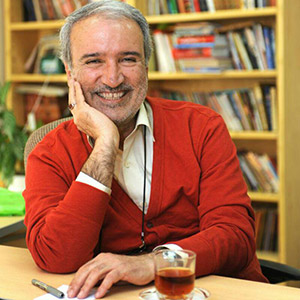A Bullet Wasn’t Able to Cope With Life
Morteza Sarhangi, the Manager in Charge of Iranian Oral History Website
Translated by: Fazel Shirzad
2018-4-25

There is no bullet made to be able to cope with life yet. The love of life reduces the fire of war. It belittles the war. Although, the war captures the youth of women, the life of men, and the childhood of children, but the light of life even remains under collapsed ceilings; alight the path of life. The stability of living in any possible form is a formal statement from humans to owners of bullets. The war comes to capture life, but the humans are those who not only appease to the forces of life, but also they are tied up with life days and pushed them forward in the toughest conditions of life. If humans wanted to cope with the forces of life, they will move from a city to another city with his belongings on back of a bike as much as possible.
For us, as we are far from the war frontiers for thousands of kilometers, these are photos that tell us what were happened to the humans. The photos are like informants during the war, and they become a strong document after the war that nobody can resist against them. There is no any friend for warlike photos except the humans; just like war literature that is most popular literature being read in the world. The world wants to know how some people, who are also humans as other people of world, lived in the heart of the war of fire, and even they had been captured and prisoned in horrific concentration camp for some years. War is a human-made phenomenon, and that is the problem of war; the humans love life, even if they are not equipped and are under threat of bullets and missiles. The humans don’t leave life, or stay and just look at it.
Human society should be congratulated for the failure of powerful world in making bullets which are not able to cope with human life; therefore, it is a ceremony that soften the steely stability of the humans, and pass over them to continue their life as a bounty from God.
Number of Visits: 3735








The latest
Most visited
The Arab People Committee
Another event that happened in Khuzestan Province and I followed up was the Arab People Committee. One day, we were informed that the Arabs had set up a committee special for themselves. At that time, I had less information about the Arab People , but knew well that dividing the people into Arab and non-Arab was a harmful measure.Kak-e Khak
The book “Kak-e Khak” is the narration of Mohammad Reza Ahmadi (Haj Habib), a commander in Kurdistan fronts. It has been published by Sarv-e Sorkh Publications in 500 copies in spring of 1400 (2022) and in 574 pages. Fatemeh Ghanbari has edited the book and the interview was conducted with the cooperation of Hossein Zahmatkesh.Is oral history the words of people who have not been seen?
Some are of the view that oral history is useful because it is the words of people who have not been seen. It is meant by people who have not been seen, those who have not had any title or position. If we look at oral history from this point of view, it will be objected why the oral memories of famous people such as revolutionary leaders or war commanders are compiled.Daily Notes of a Mother
Memories of Ashraf-al Sadat SistaniThey bring Javad's body in front of the house. His mother comes forward and says to lay him down and recite Ziarat Warith. His uncle recites Ziarat and then tells take him to the mosque which is in the middle of the street and pray the funeral prayer (Ṣalāt al-Janāzah) so that those who do not know what the funeral prayer is to learn it.


